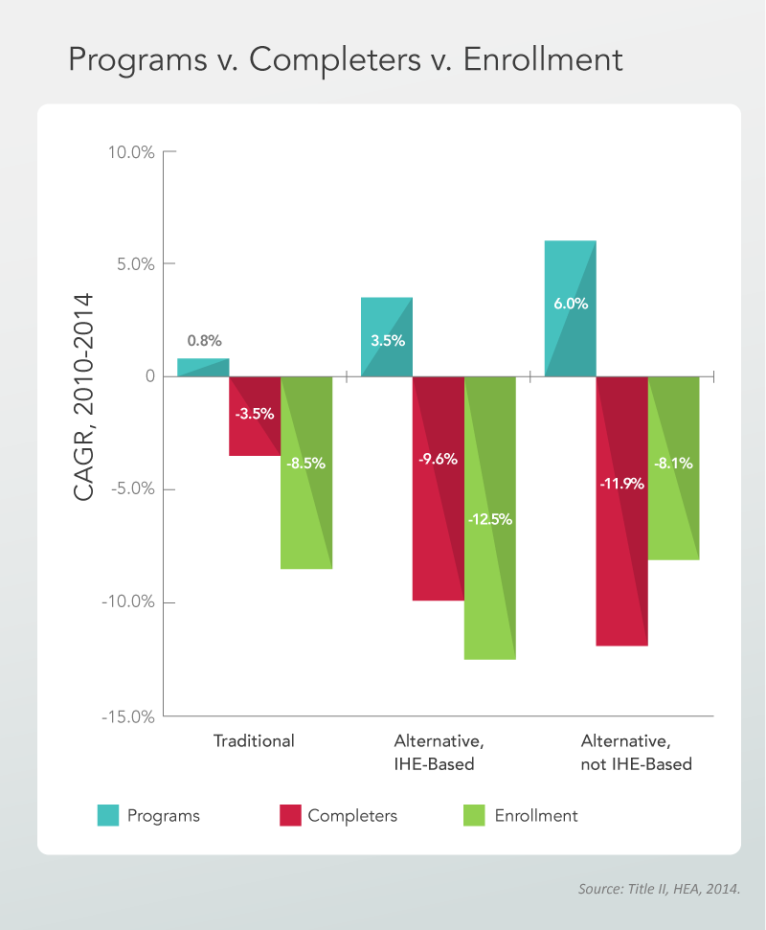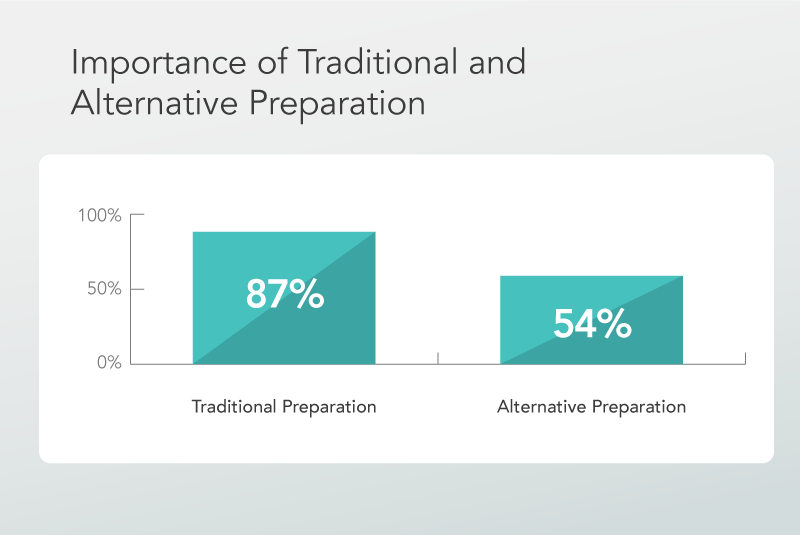Last week, Eduventures was invited to speak at the 2015 Annual Fall Meeting of the Council of Academic Deans from Research Education Institutions (CADREI). During our conversations with deans about the future of teacher preparation, the enrollment crisis for schools of education took center stage. As the media has been quick to point out, the narrative centers around the most recently available data, which indicates that enrollments are indeed declining across all teacher preparation programs:
 This data shows that the future of traditional degree programs may not be so grim and that the bright, shiny, alternative models may not be resonating as much as the national narrative would have us believe.
This data shows that the future of traditional degree programs may not be so grim and that the bright, shiny, alternative models may not be resonating as much as the national narrative would have us believe.
 This is not to say that schools of education do not face significant challenges. Enrollments and completions are declining, after all. What this data demonstrates, however, is that traditional teacher preparation programs have a story to tell and need to communicate their value more clearly. As schools of education consider the national landscape of teacher preparation and their own enrollment trends, they should collect and share stories of students and alumni, promote innovative practices and faculty successes, and align their program offerings to the needs of local district partners.
Continue the conversation. Join several school of education leaders at the upcoming Eduventures Summit 2015, as we explore the benefits and challenges of partnerships between schools of education and P-12 districts and schools with an eye toward improving educator pipelines, clinical preparation, professional development, and, ultimately, student success. Panelists will discuss their innovative strategies for building and renewing partnerships to improve outcomes for students, schools, and higher education.
This is not to say that schools of education do not face significant challenges. Enrollments and completions are declining, after all. What this data demonstrates, however, is that traditional teacher preparation programs have a story to tell and need to communicate their value more clearly. As schools of education consider the national landscape of teacher preparation and their own enrollment trends, they should collect and share stories of students and alumni, promote innovative practices and faculty successes, and align their program offerings to the needs of local district partners.
Continue the conversation. Join several school of education leaders at the upcoming Eduventures Summit 2015, as we explore the benefits and challenges of partnerships between schools of education and P-12 districts and schools with an eye toward improving educator pipelines, clinical preparation, professional development, and, ultimately, student success. Panelists will discuss their innovative strategies for building and renewing partnerships to improve outcomes for students, schools, and higher education.
- Enrollment in traditional teacher preparation programs (at colleges and schools of education) has declined 30% between 2010 and 2014, according to Title II reports.
- Master’s degree programs that prepare and develop teachers have been hit particularly hard, declining at an average rate of 5% annually between 2009 and 2013. Enrollment continued to decline in 2014, according to the National Center for Education Statistics (NCES).
 This data shows that the future of traditional degree programs may not be so grim and that the bright, shiny, alternative models may not be resonating as much as the national narrative would have us believe.
This data shows that the future of traditional degree programs may not be so grim and that the bright, shiny, alternative models may not be resonating as much as the national narrative would have us believe.
Communicating the Value of Traditional Teacher Preparation
When it comes to gauging the value of teacher preparation programs, there is no better short-term litmus test than the perceptions of principals who hire their graduates. Eduventures’ 2015 Principal Survey asked 755 P-12 principals about their hiring preferences. 87% of respondents said that traditional preparation was an important factor when evaluating candidates, compared to 54% who said that alternative preparation was an important factor. The current workforce reflects this trend, as nearly 90% of teachers are prepared through traditional preparation programs (e.g., bachelor’s, master’s, and certificate programs), despite declining enrollments. This is not to say that schools of education do not face significant challenges. Enrollments and completions are declining, after all. What this data demonstrates, however, is that traditional teacher preparation programs have a story to tell and need to communicate their value more clearly. As schools of education consider the national landscape of teacher preparation and their own enrollment trends, they should collect and share stories of students and alumni, promote innovative practices and faculty successes, and align their program offerings to the needs of local district partners.
Continue the conversation. Join several school of education leaders at the upcoming Eduventures Summit 2015, as we explore the benefits and challenges of partnerships between schools of education and P-12 districts and schools with an eye toward improving educator pipelines, clinical preparation, professional development, and, ultimately, student success. Panelists will discuss their innovative strategies for building and renewing partnerships to improve outcomes for students, schools, and higher education.
This is not to say that schools of education do not face significant challenges. Enrollments and completions are declining, after all. What this data demonstrates, however, is that traditional teacher preparation programs have a story to tell and need to communicate their value more clearly. As schools of education consider the national landscape of teacher preparation and their own enrollment trends, they should collect and share stories of students and alumni, promote innovative practices and faculty successes, and align their program offerings to the needs of local district partners.
Continue the conversation. Join several school of education leaders at the upcoming Eduventures Summit 2015, as we explore the benefits and challenges of partnerships between schools of education and P-12 districts and schools with an eye toward improving educator pipelines, clinical preparation, professional development, and, ultimately, student success. Panelists will discuss their innovative strategies for building and renewing partnerships to improve outcomes for students, schools, and higher education.
